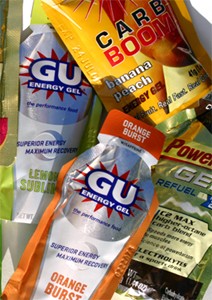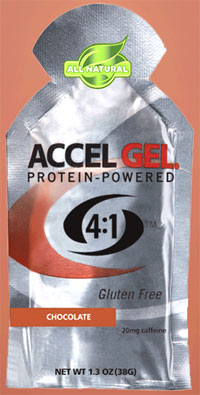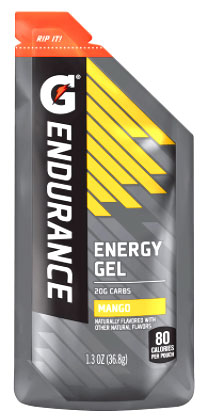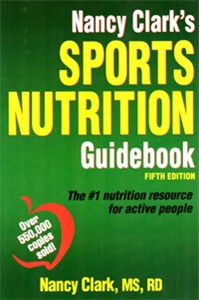|
Energy Gels
Author:
Stan Reents, PharmD
Original Posting:
11/27/2007 04:31 PM
Last Revision: 01/07/2019 01:26 PM

Documentation that carbohydrates and fats are important sources of energy for muscles was first reported in 1920! (Krogh A, et al. 1920).
And, it's now well-established that endurance exercise lasting longer than 60 minutes substantially depletes the carbohydrate (aka: glycogen) reserves in the liver and skeletal muscles (Wallis GA, et al. 2006). So, it's only logical to expect that, if you ingest carbs during prolonged exercise, this should keep you from "hitting the wall."
You might say that the "modern era" of sports nutrition began when Gatorade was developed in the mid-1960's.
In 1986, PowerBars were marketed. But while these may have been helpful for cyclists and hikers, a chewy bar wasn't a very good choice for a distance runner.
Then, energy gels (see "Terminology" below) arrived on the scene in the mid-1990's, with GU being one of the leading brands. Today, athletes and others who want quick energy during exercise have an even wider variety of sports nutrition products to choose from.
In this article, I'll review gels that provide rapidly-absorbed carbohydrates. Sports drinks, energy bars, and energy "chews" are covered in other reviews.
TERMINOLOGY
First, let's clarify the names I will be using in this review:
Virtually all of the manufacturers of carbohydrate gels call their products "energy gels." But don't be misled into thinking these are caffeine-laden products like energy drinks (eg., Monster, Red Bull, Rockstar). Energy drinks are essentially soda pop with higher amounts of caffeine. While some brands/flavors of energy gels do contain caffeine, most don't. I want to underscore the fact that energy gels can be helpful for athletes whereas energy drinks should be avoided. Due to the high carbohydrate concentration, and/or the fact that they are carbonated, energy drinks will readily cause stomach cramps if you consume them during exercise or competition.
Another name to clarify is "sports" gels. This term can be confusing because "gels" also describe oral and topical pharmaceuticals. For example, liquid-filled capsules are sometimes called "gels" or "gel caps." Topical preparations are available as "creams," "ointments," and "gels." Some sports creams (eg., BenGay, etc.) are marketed in a gel form. So, a "sports" gel is a confusing term because it could be a sports nutrition product or something you apply to sore muscles.
I also considered using the name "carbohydrate" gels since that's the most accurate label. But my elite athlete friends thought that was weird, so I scrapped that idea.
Thus, throughout this review, I'll use the term "energy" gels for rapidly-absorbed carbohydrate products that are available in a gooey gel.
WHAT'S THE RECOMMENDED AMOUNT OF CARBS TO CONSUME DURING EXERCISE?
Before we get to specific products, we need to clarify how much carbohydrate to consume while competing or exercising. Here is what Nancy Clark, MS, RD, recommends on p. 196 of her book "Sports Nutrition Guidebook, 5th ed":
DURATION AND INTENSITY
OF EXERCISE |
CARBOHYDRATE NEEDED |
| less than 45 minutes |
none |
| 1 - 2.5 hrs |
30 - 60 grams per hr |
more than 2.5 hrs,
low-to-moderate intensity |
30 grams per hr |
more than 2.5 hrs,
moderate-to-high intensity |
60 - 90 grams per hr |
DO ENERGY GELS ENHANCE ATHLETIC PERFORMANCE?
There's a ton of research documenting that consuming carbohydrates during a long race enhances performance. Because energy gels are just another way to consume rapidly-absorbed carbohydrates, what difference does it make if there's any specific research on these gels or not?
Here's the answer: HOW you ingest those carbs can make a big difference. To obtain enough carbs from sports drinks like Gatorade, you have to drink large volumes. Obviously, you don't want a lot of liquid sloshing around in your stomach while competing in a marathon or triathlon. So, obtaining those carbs in the smallest volume possible seems like a good idea. One packet of an energy gel provides the same carbohydrate amount as 12-oz. of original Gatorade.
It's worth noting that energy gels had been on the market for 15 years before it was determined that the carbohydrates provided in a gel form are equally effective in supplying energy to exercising muscles as are the carbohydrates from a liquid sports drink like Gatorade (Pfeiffer B, et al. 2010).
However, if you look at the Comments/Testimonials section on the web sites for these energy gels, you'll see comments from athletes complaining of how thick GU gels are and that they had trouble choking them down. (Then again, one athlete writes on the GU web site that he/she consumed 68 packets of GU during a single race: the 246 kilometer Spartathlon in 2015!!)
The other issue to consider is that, while all of these energy gels supply rapidly-absorbed carbohydrates, some also contain protein or amino acids. Accel Gel provides a 4:1 ratio of carbs-to-protein. GU gels and Hammer gels don't contain full proteins, but do contain individual amino acids. Are these brands better than carb-only gels?
So, for a variety of reasons, it's useful to know if energy gels can enhance performance.
Unfortunately, even though these products have been on the market since the mid-1990's, and considering their popularity with athletes, there's surprisingly little research documenting their effects on performance. Pacific Health Labs -- which produces Accel Gel, Accelerade, and Endurox -- points out on their web site that Accel Gel has been studied in 7 peer-reviewed studies (web site accessed January 2, 2019).
I attempted to track down those studies:
If you click on the "Science" tab (on the Pacific Health Labs web site), it brings you to a list of research. However, only 6 citations are provided, not 7. Of those, I could only find one. Several appear to be presentations at scientific meetings and it appears those were never published in a peer-reviewed journal. I couldn't locate the others no matter how many ways I searched for them on PubMed.
So, here's a summary of the one study listed on the Pacific Health Labs web site that I could obtain. It compares Accel Gel to GU:
Accel Gel vs. GU Gel During Cycling
This study was conducted by Michael J. Saunders, PhD, and colleagues at James Madison University (Saunders MJ, et al. 2007). Dr. Saunders is a leading researcher on how carbohydrate and protein consumption affect athletic performance.
In this study, 13 "recreationally competitive" cyclists performed 2 rides to exhaustion at 75% VO2max on a stationary cycle ergometer in the lab. During one ride, they received a gel containing carbs + protein (Accel Gel) and during the other test, they received a carbs-only gel (GU). The amount of carbohydrates in each gel was identical. They consumed gel every 15 minutes while riding, and then one large dose after the ride ended.
RESULTS: The cyclists were able to ride 13% longer while consuming the carb + protein gel: 117 minutes versus 103 minutes. Improvement was seen in both males and females.
However, there are 2 details to consider before we conclude that Accel Gel is superior to GU:
• Calorie intake wasn't equal: The carbohydrate content in the 2 gels was equal, but, because one also contained protein, that increased the total amount of calories supplied. Protein isn't a major energy source during exercise (Tarnopolsky M. 2004), but it does supply some calories.
• Today's GU contains amino acids: This study was done back in 2006-2007. The authors describe the GU gel they used as containing only carbs. However, today's formulation contains 3 branched-chain amino acids. So, it would be incorrect to say that Accel Gel is superior to GU based on this study. The more accurate take-away would be to say that Accel Gel was superior to a carb-only gel.
Energy Gels: Use During Distance Running
Researchers in Australia concluded that consumption of a carbohydrate energy gel didn't improve running performance. However, the results were dramatically affected by a poor response in 3 athletes:
Eighteen trained distance runners ran 2 half-marathons, 3 weeks apart. During one, they consumed 426 ml of water, and during the other, they consumed an equivalent amount of water with a carbohydrate energy gel. The runners ingested 1.1 grams of carbohydrate per kilogram of body weight from the gel.
RESULTS: The average finish time was 14 seconds faster when the half-marathoners consumed a carbohydrate gel. Certainly, this could be the difference between winning a race and finishing in 2nd place, but, statistically, it wasn't significant. Why?
One explanation is the duration of running. These were elite runners: their average finish time for a half-marathon was a very impressive 71 minutes. It's possible that if they ran longer, the benefits of carbohydrate consumption would be more evident.
But this might be the real reason:
Three runners complained of GI discomfort from the carbohydrate gel. This prolonged the finish time in these 3 athletes by an average of 105 seconds. Since there were only a total of 18 runners, the poorer performance in these 3 reduced the improvement in average finish time of the entire group to only 14 seconds. Because of side effects, and the fact that the improvement in performance was slight, the researchers concluded that the use of energy gels is not warranted during a half-marathon (Burke LM, et al. 2005).
I think this study is misleading. It would be helpful to see a similar study that included 60-80 athletes. This would clarify what percent of athletes develop GI problems when consuming these gels during a distance run. And, an exercise duration longer than 71 minutes would produce a greater degree of glycogen depletion.
PROBLEMS WITH ENERGY GELS
Stomach Cramps, GI Intolerance
Note the study I summarized above where 3 out of 18 well-trained runners complained of "gastrointestinal discomfort" when consuming carbohydrate gels during a half-marathon (Burke LM, et al. 2005).
It's possible that when carbohydrate gels cause GI cramps, athletes just aren't drinking enough water with them. (Most of the manufacturers of these gels specifically mention that they should be consumed with water.) Extensive research over the past several decades has revealed that, when the carbohydrate concentration in a sports drink is greater than 6-8%, GI intolerance and nausea are more likely.
At 6%, 200ml of a sports drink provides only 12 grams of carbohydrate. But, most of these energy gels provide 20-30 grams of carbohydrate in a single, small packet. So, it makes sense that consuming too little water while using these energy gels may partially explain why some athletes develop GI intolerance.
The foil packet irritates my mouth!
All of the manufacturers market their gels in a flat foil packet so you can tear off the top and suck the contents out. But, the foil is stiff and the edges feel like they are slicing into the corners of my mouth. This may be a minor gripe, but I don't think so. Try consuming several packets during your next run or bike ride and see what you think. Manufacturers need to market these products in a toothpaste-like container, ie., something without any sharp edges. On this point, chewable forms such as Clif Shot BLOKS and Sport Beans are an advantage.
They're expensive
Yes, energy gels are a "scientific" blend, but when you get down to it, these products are mostly just simple sugars. Retailing for $1-2/each, that seems high, especially when you might consume 6-10 packets during a century bike race or a marathon. I wonder if packets of honey, or, some maple syrup would provide the same benefit!
SPECIFIC PRODUCTS
These carbohydrate-based sports products can be grouped into gels that also contain protein or amino acids and those that are carb-only. Four brands contain protein or amino acids, while 4 other brands do not. Some also contain vitamins, electrolytes, and/or caffeine.
DISCLAIMER: There are a lot of these products on the market. Manufacturers can change their formulation (ingredients and flavors) at any time. Check the label of each one before you buy it.
Energy Gels That Contain Protein or Amino Acids:

• Accel Gel (by Accelerade, www.Accelerade.com): Each packet of Accel Gel contains 20 g carbs with 5 g of protein, to provide a total of 100 calories. Sodium, potassium, vitamin C, and vitamin E are also included. As of January 2019, Accel Gel is available in 6 flavors. Two flavors contain caffeine: Chocolate and Raspberry Cream.
• Enervit Gel and Liquid Gel (by Enervit, www.EnervitSport.com): Enervit (based in northern Italy) markets dozens of sports nutrition products. As of January 2019, they offer 14 different energy gels: a 25-ml tear-open foil packet in 7 different flavors, a 12.5-ml foil packet that only requires one hand (it appears you fold it in half and squeeze) in 2 flavors, and a 60-ml "liquid gel" with a screw-cap in 5 flavors. It appears this screw-top packet is meant for sipping. There are too many formulations to summarize here. Some contain branched-chain amino acids and others don't. Several flavors contain 25 mg caffeine per packet, but most are caffeine-free.
• GU Energy Gel (www.GUEnergy.com): GU introduced the world to energy gels in the mid-1990's. As of January 2019, they offer GU gels in 18 different flavors. GU Energy Gels contain 21-23 g of carbohydrates and 100 calories per packet. They do not contain whole protein (note that the Nutrition Facts panel lists "zero grams" for Protein), but do contain 3 branched-chain amino acids: isoleucine, leucine, and valine. (As recently as 2012, a 4th amino acid -- histidine -- was also included in the formulation.) Eleven of the 18 flavors contain caffeine (from green tea extract). They recommend 1 packet (with water) 15 minutes before and every 45 minutes during exercise.
• Hammer Gel (by Hammer Nutrition, www.HammerNutrition.com): Each packet contains 88-93 calories. The carbohydrate source is "long-chain maltodextrin." Also includes 4 amino acids: alanine, isoleucine, leucine, and valine. Available in the following flavors: apple-cinnamon, banana, chocolate, espresso, orange, plain, raspberry, tropical, and vanilla.
Energy Gels That Do NOT Contain Protein or Amino Acids:
• Carb BOOM! Energy Gel (by Carb-BOOM, www.BoomNutrition.com): One packet contains 26 g of carbohydrate and 110 calories. Each packet also provides sodium and potassium but no protein or amino acids. As of January 2019, they are available in 6 flavors: apple cinnamon, banana peach, grape pomegranate, raspberry, strawberry kiwi, and vanilla orange. The vanilla orange flavor contains 25 mg caffeine per packet.
• Clif Shots (by Clif Bar, www.ClifBar.com): First, it is important to point out that Clif Bar uses the name "Clif Shot" on several different products: in addition to energy gels, they also market a recovery beverage and an electrolyte beverage under the Clif Shot name. The main carbohydrate in their energy gels is organic brown rice syrup. Clif Shot Energy Gels come in a variety of flavors: apple pie, chocolate, double espresso, mango, mocha, razz, strawberry, and vanilla. The mocha flavor contains 50 mg caffeine; the double espresso contains 100 mg caffeine.
• CytoMax Energy Gel (by CytoSport, www.CytoSport.com): Each packet contains 27 g carbohydrates, 110 calories, sodium, potassium, vitamin A, vitamin C, vitamin E, and chromium. Available in orange and vanilla flavors.
• Gatorade Endurance Energy Gel (by Gatorade, www.Gatorade.com): Gatorade's energy gels contain 20 grams of carbs and no protein or amino acids, providing a total of 80 calories per packet. Each packet also contains 90-100 mg sodium and 35 mg potassium. As of January 2019, Endurance Energy Gels are available in 4 flavors: apple pear, blackberry, mango, and vanilla.
• Honey Stinger Gel (by Honey Stinger, www.HoneyStinger.com): This product is based on pure honey. The strawberry and "ginsting" (their name, not a typo!) flavors contain kola nut extract, which is a natural source of caffeine. Available in banana, chocolate, "ginsting," gold, mint, and strawberry flavors.
• PowerBar Gel / PowerGel: According to the manufacturer, this product will disappear from the marketplace by the end of 2018 or early 2019.
WHICH PRODUCTS TASTE BEST?
Taste is so subjective that it's pointless to recommend a product on this basis.
I prefer the chocolate- and coffee-flavored products (especially if they contain some caffeine!). Some people don't mind gels that resemble cake frosting ("raspberry creme" for example), but those are way too sweet for me. If I'm only going to consume 1 or 2 packets, not so bad. But, if you consume a lot of packets, it gets a little overwhelming.
You have to find what you like. And you should definitely figure this out before an important race. The last thing you want in the middle of a marathon is to develop a queasy stomach, especially from something that is supposed to help your performance!
RECOMMENDATIONS
Because I'm a (former) health care professional, I believe that health/fitness/performance claims must be backed-up by solid research. Based on the research from Dr. Saunders I summarized above, it appears that a gel that also contains protein or amino acids may have advantages over a carb-only gel...assuming it doesn't give you stomach cramps!
Accel Gels are unique in that they provide a 4:1 ratio of carbs-to-protein in each of their 6 flavors. Several other brands contain branched-chain amino acids. If you're going to be exercising/competing at an intense level, and you're concerned about some serious muscle soreness the following day, then this might be another reason to chose these products. However, if all you're looking for is rapidly-absorbed carbohydrates, then choose a carb-only gel.
Regardless of which brand you use, it's very wise to try them before an actual race to see how well you react to them. For any brand, here are a couple general recommendations:
• Drink enough water: Consuming energy gels can cause stomach cramps. Make sure you drink some water with each packet.
• Simple is better: In general, your body doesn't need protein, fats, vitamins, or herbs during exercise. So, when in doubt, use products that only contain carbohydrates. The only additional ingredients that are acceptable here are (a) sodium if you are perspiring heavily and (b) caffeine if you like its effects and it doesn't bother you.
FOR MORE INFORMATION
Liz Applegate, PhD, wrote a nice review of energy gels for the October 2003 issue of Runner's World magazine. However, many new products have been marketed since then.

In 2014, Nancy Clark, MS, RD, published the 5th edition of her popular Sport Nutrition Guidebook. This book has sold over 550,000 copies. She explains how to consume carbohydrates before and during exercise in Chapter 9, though there is almost no discussion of energy gels in this book.
Readers may also be interested in these reviews:
EXPERT HEALTH and FITNESS COACHING
Stan Reents, PharmD, is available to speak on this and many other exercise-related topics. (Here is a downloadable recording of one of his Health Talks.) He also provides a one-on-one Health Coaching Service. Contact him through the Contact Us page.
REFERENCES
Backhouse SH, Bishop NC, Biddle SJH, et al. Effect of carbohydrate and prolonged exercise on affect and perceived exertion. Med Sci Sports Exerc 2005;37:1768-1773. Abstract
Burke LM, Wood C, Pyne DB, et al. Effect of carbohydrate intake on half-marathon performance of well-trained runners. Int J Sport Nutr Exerc Metab 2005;15:573-589. Abstract
Campbell C, Prince D, Braun M, et al. Carbohydrate-supplement form and exercise performance. Int J Sport Nutr Exerc Metab 2008;18:179-190. Abstract
Koopman R, Pennemans DLE, Jeukendrup AE, et al. Combined ingestion of protein and carbohydrate improves protein balance during ultra-endurance exercise. Am J Physiol Endo Metab 2004;287:E712-E720. Abstract
Krogh A, Lindhard J. The relative value of fat and carbohydrate as sources of muscular energy. Biochem J 1920;14:290-363. Abstract
Leelayuwat N, Tsintzas K, Patel K, et al. Metabolic responses to exercise after carbohydrate loads in healthy men and women. Med Sci Sports Exerc 2005;37:1721-1727. Abstract
Pfeiffer B, Stellingwerff T, Zaltas E, et al. CHO oxidation from a CHO gel compared with a drink during exercise. Med Sci Sports Exerc 2010;42:2038-2045. Abstract
Saunders MJ, Luden ND, Herrick JE. Consumption of an oral carbohydrate-protein gel improves cycling endurance and prevents postexercise muscle damage. J Strength Cond Res 2007;21:678-684. Abstract
Tarnopolsky M. Protein requirements for endurance athletes. Nutrition 2004;20:662-668. Abstract
Wallis GA, Dawson R, Achten J, et al. Metabolic response to carbohydrate ingestion during exercise in males and females. Am J Physiol Endocrinol Metab 2006;290:E708-E715. Abstract
ABOUT THE AUTHOR

Stan Reents, PharmD, is a former healthcare professional. He is a member of the American College of Lifestyle Medicine (ACLM) and a member of the American College of Sports Medicine (ACSM). In the past, he has been certified as a Health Fitness Specialist by ACSM, as a Certified Health Coach by ACE, as a Personal Trainer by ACE, and as a tennis coach by USTA. He is the author of Sport and Exercise Pharmacology (published by Human Kinetics) and has written for Runner's World magazine, Senior Softball USA, Training and Conditioning and other fitness publications.
DISCLOSURE: Neither the author, nor AthleteInMe, LLC, has any relationship with any of the products or manufacturers mentioned in this review.
Browse By Topic:
carbohydrates, energy bars, energy chews, energy gels, fluids and electrolytes, nutrition recommendations, protein, sports drinks, sports nutrition
Copyright ©2025 AthleteInMe,
LLC. All rights reserved.
|